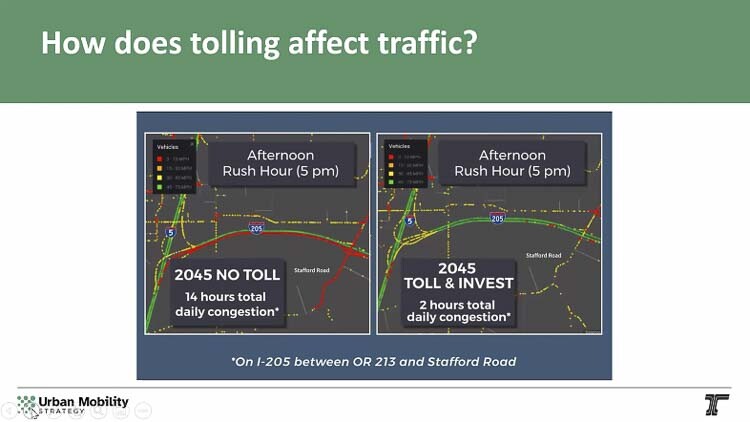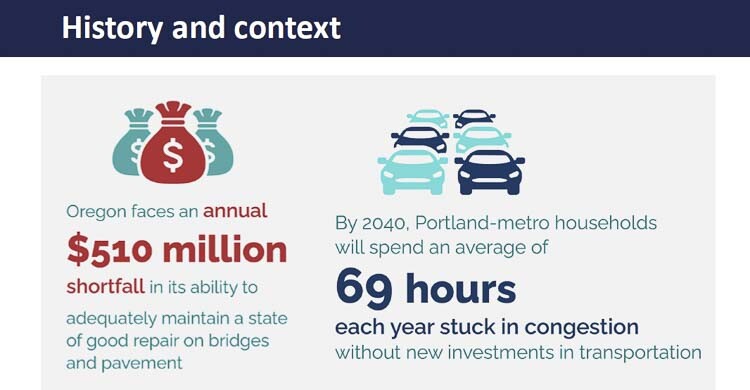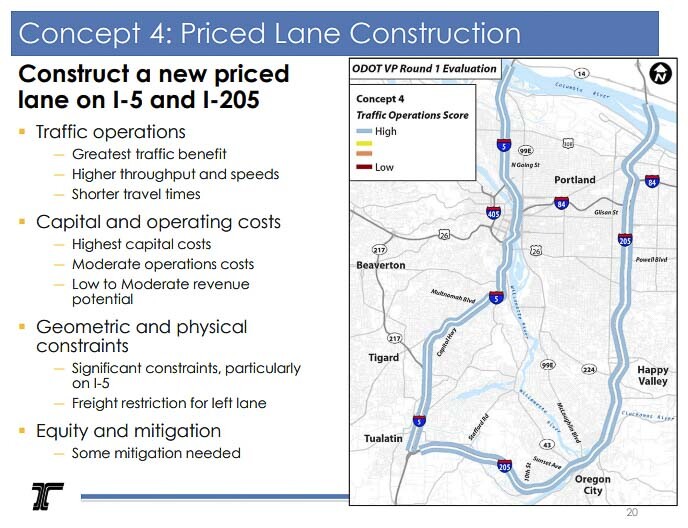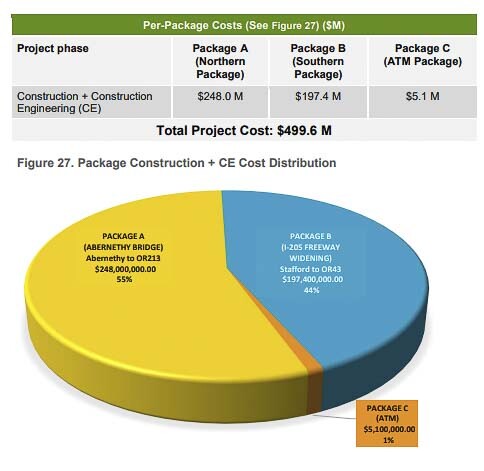Tolling traffic diversion likely to get worse without new lanes on I-205
John Ley
for Clark County Today
Recent news reports indicate the Oregon Department of Transportation (ODOT) “indefinitely pauses I-205 projects, tolling,” and another stated “scrapping tolling on an I-205 bridge, even as it moves forward with tolling on a second span.” ODOT officials have also formally announced they have canceled plans to build a third lane between the Abernethy Bridge and Stafford Road.
Some citizens might be tempted to breathe a sigh of relief regarding tolls, but there’s much more to the story. Tolling is still very much part of ODOT’s plan to raise money. They have roughly a $3 billion funding hole for its transportation projects that began with HB 2017. It was supposed to be a $5.3-billion package passed by the Oregon legislature six years ago.
The Portland metro area has been pushing a Regional Mobility Pricing Program (RMPP), which could charge a “per mile” toll for drivers on all area freeways. One option would charge a flat fee for entering the highway. An additional toll would be charged for driving into a high traffic area.These tolls would begin at the border with Washington.
The RMPP will cover 42 miles of highway (I-5 and I-205) from the Boones Bridge to the Columbia River. ODOT has embraced the plan and briefed the Regional Toll Advisory Committee (RTAC) meeting on Monday. The topic has also been discussed by the Statewide Toll Rulemaking Advisory Committee (STRAC) meetings, most recently in July.
This is of interest for Clark County residents because over 75,000 people commute to work in Oregon, paying $251 million in 2019 Oregon income taxes. The tolling would harm hard working low and middle income families. Economist Joe Cortright has estimated the combination of bridge tolls and per mile tolls could be as much as $28 – $31 per day for a round trip from Vancouver to Wilsonville.

Saving travel time is the overwhelming top priority of residents on both sides of the Columbia River. ODOT officials had previously informed citizens that completing the full I-205 project (Abernethy Bridge plus 7 miles of new lanes) would eliminate 12 hours of traffic congestion by 2045.
Washington County Commissioner Nafisa Fai asked the most important question of the RTAC meeting. She referenced the earlier promised 12-hour reduction, and wanted to know how much time would be saved under the current plan. The ODOT staff and WSP consultants didn’t have an answer.
Clackamas County Commissioner Paul Savas referenced the same promised time savings, and then tackled the significant traffic diversion the tolls will cause. He said the promised $30 million to mitigate the negative impacts of diversion was not enough, calling it “woefully inadequate.”.
Jana Jarvis of the Oregon Trucking Association asked whether or not there’s enough vehicle capacity in the Portland area. It’s been 40 years since I-205 was built, adding a bypass to I-5 and adding capacity for freight haulers and vehicle traffic.
David Ungemah from WSP shared that when managed lanes are created, “there is more traffic coming off the arterials, back onto the freeway.” He told Jarvis there was “an improvement when a new tolled lane was added” with the increased capacity.
In community presentations three years ago, ODOT showed significant increases in traffic on already congested side roads, due to the tolling. Canby Council President Tim Dale stated emphatically: “you’re actually going to make things worse!” ODOT admitted their “single largest concern” is traffic diversion.
In their presentation at the time regarding I-205 tolling they stated:
“Perhaps the largest single concern in evaluating alternatives, is the effect on roadways in the vicinity of I 205 tolling due to local rerouting. While the complete effect on rerouting cannot be precisely identified by the regional model, (especially when also considering the potential for shifts in the time of trips or changes in destination to avoid tolls), the influence of these factors is likely to positively affect traffic operations on I-205.
Specific local congestion effects (e.g., key intersection traffic performance relative to jurisdictional mobility standards) will be assessed through the NEPA evaluation of impacts. Additional study of the effects of rerouting on local roadways will be part of subsequent analysis using the DTA modeling tool, which will provide much more detail on rerouting impacts for use in analyzing alternatives, and ultimately identifying the preferred alternative.”
Fast forward to today, ODOT has canceled the planned addition of a 7-mile new lane in each direction to I-205. With less vehicle capacity, it is likely there will be even more vehicles diverting onto side streets due to the tolls. Furthermore, ODOT plans to charge higher prices during congested periods, so the lack of the new third lane guarantees higher priced tolls.

The Federal Highway Administration generally prohibits tolling on existing lanes of a federal highway. RTAC shared “With two unique exceptions discussed below, every managed lane facility in the United States is the result of a conversion of an existing HOV lane (not general-purpose) or construction of new lanes, and not conversion of a general-purpose lane.”
“In a sense, managed lane revenues are dependent on poor conditions in the adjacent general-purpose lanes,” ODOT said. “If improvements are made to travel conditions in the general-purpose lanes, there will be less demand for the uncongested, tolled alternative, thus lowering revenues.”
Their slides also noted: “Revenues from the I-405 Express Lanes in Seattle, for example, have still not recovered to their pre-COVID levels and are currently estimated at 45 percent relative to 2019.” The five Washington tolling facilities had to be bailed out with general fund revenues from the legislature for the 3 years of the pandemic.The SR-99 tunnel is permanently “under water” from a financial perspective, according to the Washington State Transportation Commission.
“In short, the response of drivers to managed lanes during the reduced travel demand brought about by COVID-19 shows that when demand is reduced, managed lane volumes are the first to drop and the last to recover. As a result of overall managed lanes revenue volatility, they are difficult to leverage into other funding sources such as bonds. Fully tolled facilities are more reliable in terms of revenue generation and frequently support large bonding packages.”
ODOT is only pushing for all lanes to be tolled. The “managed lanes” are a combination of tolled lanes and free “general purpose” lanes.“Given their volatility and relatively low levels of revenue generation, managed lanes are not considered to be a reliable or sustainable source of revenue for transportation investment within the Portland region and therefore do not meet the project purpose and need.”
ODOT then referenced constructing a new managed lane. It has the “lowest potential for mode shift due to presence of higher performing general purpose lanes”. They also report “Highest number of non-tolled trips,” which would eliminate equity concerns.
This is reminiscent of the 2018 ODOT “Value Pricing” committee deliberations. Eight options were initially presented. The one option with the best outcomes in reducing travel times and congestion was taken off the table by ODOT staff and their WSP consultants. It had the: “Greatest traffic benefit” and “Higher throughput and speeds” plus “Shorter travel times”.

Option 4 was the most practical solution back then and now. Build a new lane in each direction on both I-5 and I-205, and only toll the new lanes that are built. This option had the BEST results for traffic flow and reducing congestion, because it added vehicle capacity. It also offered the best “equity” outcome, as low and middle income families could avoid the tolls unless they really needed the faster travel times of the tolled lane.,
But this wasn’t discussed during the RTAC committee meeting. Sam Kim, the moderator, kept things moving along, encouraging people to provide additional questions and input via email.
The ODOT agenda asked the RTAC to find ways to accelerate tolling. The first question: “What opportunities exist to accelerate the schedule for delivery of the Regional Mobility Pricing Project to reduce the implementation gap between RMPP and the I-205 Toll Project?”
It could be suggested that ODOT’s priority was not about reducing traffic congestion or saving people time. It wasn’t about avoiding the negative impacts of traffic diversion. Instead, it was finding a new source of money and getting it implemented as soon as possible.
ODOT officials asked for strategies to mitigate diversion. However, it’s reasonable to suggest that if they don’t cause the traffic diversion to begin with, they won’t have to mitigate it. Especially in Clackamas County and along the Willamette River, there are few alternative routes and almost no transit as an alternative.
At the July STRAC meeting, an Oregon freight hauler said his community is frustrated with ODOT. “Our food, medicine and housing are all reliant on good roads,” said Mike Card. He owns Combined Transport, with 500 trucks that drive one million miles a year on Oregon roads. Card believes everyone should pay the same, if there is a toll.
Card noted the six goals of the STRAC are incompatible with each other. He said it’s not ODOT’s role to provide “equity” via tolling. That job belongs to the legislature, in their tax and spending policies.
STRAC’s Elizabeth Myers noted that transit doesn’t work for her. It would take multiple transfers and an hour and 45 minutes for her to get to work on transit.

Citizens would rightly be concerned about multiple aspects of tolling in Oregon. They raised such a ruckus that Gov. Tina Kotek issued an executive order, prohibiting ODOT from collecting toll revenues until at least January 2026.
Local elected officials continue to hear from their constituents. Tualatin Mayor Frank Bubenik told the RTAC members his citizens have no other options. “All the transit is in Portland,” he said.
TriMet told the committee that they can’t expand service yet. They are focused on restoring service from pandemic cuts, hoping to have service fully restored by 2026.
The Tualatin Chamber of Commerce has created a website to keep citizens up to speed on issues related to tolling. Oregon Tolling Updates is providing weekly updates and podcasts to keep people informed.
The RTAC had been meeting monthly. They are planning to meet bi-monthly in the future, reducing opportunities for citizen input.
Oregon citizens can sign IP-4 to guarantee a Vote Before Tolls. The initiative would amend the Oregon Constitution, bypassing the legislature.
Also read:
- Opinion: Hiding the growing cost of the Interstate Bridge replacementJoe Cortright of the City Observatory addresses the rising cost of the Interstate 5 Bridge replacement project.
- 90 minutes of delay on Southbound I-5 in Southwest Washington on Friday afternoon, July 26Travelers using southbound Interstate 5 through Woodland should expect up to 90 minutes of delay during Friday afternoon and evening and should delay travel or prepare for additional travel time.
- Nighttime paving work on I-5 and SR 14 in Clark County July 28-Aug. 9Nighttime travelers in Clark County should expect delays for maintenance and paving work beginning Sunday, July 28 until the morning of Friday, Aug. 9.
- Northeast 182nd Avenue/Northeast Ward Road to be closed on Aug. 1Northeast 182nd Avenue and Northeast 172nd Avenue in Clark County will have single-day closures on August 1 and August 5 for road preservation, with detours in place.
- Interstate Bridge Replacement program awarded $1.499 billion FHWA Bridge Investment Program grantInterstate Bridge Replacement program officials have shared that the program received $1.499 billion through the Federal Highway Administration’s Bridge Investment Program.









